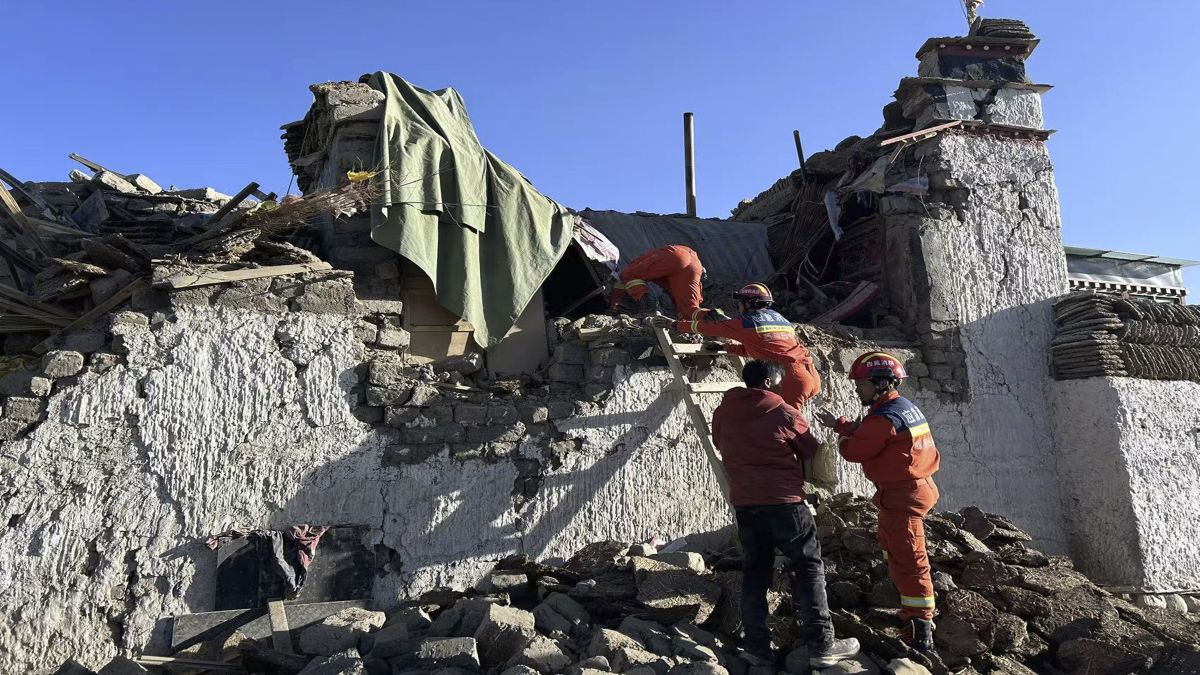People in Tibet woke up to a powerful earthquake — measuring 7.1 on the Richter scale — on Tuesday (January 7), which has now claimed the lives of more than 95 people. The earthquake even shook buildings in many areas in India’s Delhi, Bihar, West Bengal and even Assam, and even in India’s neighbouring countries, Nepal and Bhutan.
Soon after the quake occurred in the Shigatse region of Tibet, people from Delhi shared dramatic visuals of their houses swaying violently owing to the impact of the quake.
But why is it that Delhi and its surrounding region often experience tremors from quakes that hit areas far away? We examine.
Powerful quake jolts Tibet
On Tuesday morning, a powerful quake of 7.1 magnitude struck Tingri county in Tibet. While the US Geological Survey reported the tremor as magnitude 7.1, China Earthquake Networks Centre said that the temblor measured 6.8.
The quake caused the collapse of many buildings, resulting in the death of 95 people and injuring many others. Videos published by China’s state broadcaster CCTV showed houses destroyed with walls torn apart. Xinhua later reported that more than a thousand houses have been damaged owing to the quake.
Sangji Dangzhi, whose supermarket in Tingri county suffered considerable damage, told AFP that the situation was “very serious” with ambulances taking people to hospital throughout the day. “Here the houses are made from dirt so when the earthquake came… lots of houses collapsed,” the 34-year-old, who returned home from Shigatse after the quake struck, told AFP by phone.
Following the quake in Tibet, China’s President Xi Jinping has ordered that officials do all they can to provide aid and relief. Meanwhile, Tibet’s spiritual leader the Dalai Lama said he was “deeply saddened” and was offering prayers for those killed in the temblor. “I am deeply saddened to learn of the devastating earthquake… It has caused the tragic loss of many lives, numerous injuries, and extensive destruction to homes and property,” the leader said in a statement. “I offer my prayers for those who have lost their lives and extend my wishes for a swift recovery to all who have been injured.”
The earthquake’s epicentre was around 80 km north of Mount Everest, the world’s highest mountain and a popular destination for climbers and trekkers.
AP reported that three hours after the quake, about 50 aftershocks were recorded with Xinhua reporting that the largest was 4.4 in magnitude.
Tremors felt in India and Nepal
The tremors from the Tibetan earthquake could be felt in Nepal as well as in parts of India. In Kathmandu, 400 km away from the epicentre, residents ran out of their houses when they felt the tremors.
“We felt a very strong earthquake but so far we have not received any report of injuries or physical loss,” said Anoj Raj Ghimire, chief district officer of Solukhumbu district in Nepal. This was confirmed by Nepal’s National Disaster Risk Reduction and Management Authority.
The quake also jolted Thimphu, the capital of Bhutan.
People in different parts of north and east India also shuddered as the quake struck Tibet. In Delhi, people took to social media to share videos of the furniture rattling in their house owing to the quake. People in Bihar’s Patna also shared similar videos as they experienced tremors.
#WATCH | Earthquake tremors felt in Bihar's Sheohar as an earthquake with a magnitude of 7.1 on the Richter Scale hit 93 km North East of Lobuche, Nepal at 06:35:16 IST today pic.twitter.com/D3LLphpHkU
— ANI (@ANI) January 7, 2025
Delhi’s tremors
But why is it that India’s capital keeps experiencing tremors? A lot has to do with the quake’s location and Delhi’s position.
We explain. Today’s earthquake occurred in Xizang, also known as the Tibet Autonomous Region. It is one of the world’s most earthquake-prone areas because the Indian and Eurasian tectonic plates are continuously colliding. Delhi is situated in close proximity to the Himalayan ranges, making it vulnerable to the seismic activity emerging from the plates.
It is because of this very reason that Delhi has been placed under Zone IV in the country’s seismic zoning — which indicates a higher likelihood of experiencing moderate to high-intensity earthquakes.
Apart from geological factors, the unique settlement pattern of Delhi is one of the reasons why the area often experiences tremors. Several high-rise constructions are also present in this area, making it easier for people to feel tremors. Also, the areas along the banks of the Yamuna and Hindon, house several multi-storey buildings — this region is in the most seismic-prone zone.
Moreover, today’s earthquake had a shallow depth of just 10 kilometres, which contributed to the intensity of the tremors felt in Delhi.
It is perhaps owing to these factors that Delhi often experiences tremors. For instance, in early November 2023, the capital and its neighbouring areas experienced four such instances of tremors within a month. This had made many question if a big earthquake would soon hit Delhi.
Even January 2024’s Pakistan earthquake with its epicentre in the Hindu Kush region of neighbouring Afghanistan shook Delhi-NCR.
With inputs from agencies


)

)
)
)
)
)
)
)
)



